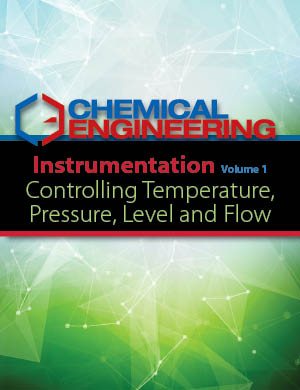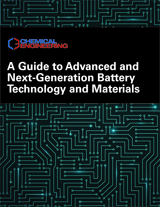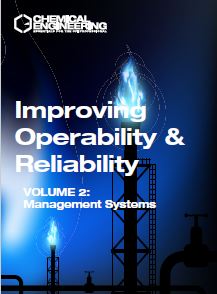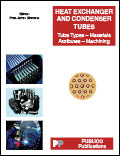Description
Volume 1 of this 2-part guidebook contains useful “Facts at Your Fingertips” guide sheets, and practical, how-to engineering articles, all of which were originally published in Chemical Engineering.
Proper selection, specification and use of instrumentation is essential for optimal operation of chemical process industries (CPI) facilities. The detailed engineering articles contained in Volume 1 of this 2-volume set provide guidance on monitoring and controlling several key process variables — pressure, temperature, level and flow, and several articles are provided on the appropriate measurement of pH, as well.
The engineering support on pressure monitoring focuses on the accurate measurement of low pressures, high pressures and overpressure, and several articles focus on the proper use of rupture disks and pressure-relief valves to manage high-pressure situations, too.
The guidance on temperature monitoring provides coverage of competing methods, including RTD sensors, remote infrared thermal sensors, thermowells and other analytical options.
Specific articles focus on addressing the challenges of temperature measurement in extremely cold climates. The articles on measuring flow focus on applications handling both fluids and bulk solids or particulate materials.
Delivered in a PDF, 97 pages.
Table of Contents
Characterize Bulk Solids to Ensure Smooth Flow…………………………………………………………………………………………3
To minimize problems associated with handling all types of bulk solids, engineers must adopt a systematic approach to
characterizing the flow and mechanical properties of the materials under a variety of operating conditions
Stream Selection Assemblies For Analytical Instrumentation……………………………………………………………………….13
Intelligent selection and specification help to assure getting representative, uncontaminated samples from multiple process
lines to a shared analyzer
Extremely Low-Temperature Systems…………………………………………………………………………………………………………17
Understanding the nuances of low-temperature engineering is key to safe and efficient operations
New Measurement Practices for Cold Climates……………………………………………………………………………………24
Selecting the right pressure, temperature, flow and level meters and connection systems can help to eliminate the need for
heated enclosures and sensing lines
Low-Pressure Measurement…………………………………………………………………………………………………………………….. 29
Avoiding Pressure Relief Problems……………………………………………………………………………………………………………. 30
pH Electrodes and Temperature Dependence…………………………………………………………………………………………….. 31
Infrared Temperature Measurement…………………………………………………………………………………………………………… 32
Selecting Two- and Four-wire Magnetic Flowmeters…………………………………………………………………………………… 33
Thermowell Installation……………………………………………………………………………………………………………………………. 34
Level- Measurement Device Selection……………………………………………………………………………………………………….. 35
Flowmeter Selection…………………………………………………………………………………………………………………………………. 36
Liquefied- Industrial-Gas Safety………………………………………………………………………………………………………………… 37
Level Measurement Devices……………………………………………………………………………………………………………………… 38
Fluid Flow………………………………………………………………………………………………………………………………………………… 39
Using Rupture Disks with Pressure Relief Valves………………………………………………………………………………………… 40
Managing Pressure while Pigging an Oil Pipeline………………………………………………………………………………………. 41
Pressure control valves can manage pressure in oil pipelines, but pigging the line presents a challenge
Vessel Sizing and Level Instrumentation……………………………………………………………………………………………………..43
When sizing process vessels, it is important to consider instrumentation. Consistent, safe and reliable results depend on it
Remote Thermal Sensing……………………………………………………………………………………………………………………………48
By making it easy to detect heat anomalies, thermal cameras and infrared thermometers support preventive and predictive
maintenance
Pressure-Vessel Quality Control Requirements……………………………………………………………………………………………53
Understanding what is required for boiler and pressure-vessel manufacturers can help scheduling and cost assessments
INFRARED TEMPERATURE MONITORING: Know the Right Questions to Ask………………………………………………..61
The infrared approach is especially useful in situations where process temperatures are extremely high, the target is in
motion, and the need to avoid contaminants is significant
Advances in Process Temperature Measurement: Trends and Technologies…………………………………………………..66
Process temperature measurement is a constantly evolving field, and new technologies have allowed for more reliable
measurements to be realized in many applications
Field Troubleshooting 101 and How to Get the Job Done……………………………………………………………………………..70
A major part of field work lies in troubleshooting problems: finding out why a system is not operating the way it is intended.
This article provides guidelines for effective troubleshooting and contains many practical examples of their successful
Warming up to Accurate Temperature Measurement……………………………………………………………………………………77
Proper specification, installation and operation can ensure the accuracy required of your temperature sensor
Optimizing Pressure Relief Systems……………………………………………………………………………………………………………81
Alternative designs for pressure relief systems may offer investment cost savings
Pressure Transmitter Basics: Selection Guidelines……………………………………………………………………………………….87
Climbing the decision tree to pick the right pressure sensor
pH Measurement in Industrial Waters…………………………………………………………………………………………………………93
Applying CPI Temperature Sensors……………………………………………………………………………………………………………..94
Don’t fall back on outdated rules of thumb that may no longer be valid, or ‘plug and play’ solutions that may not be applicable




